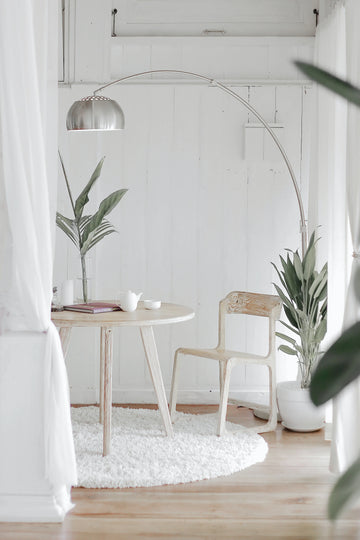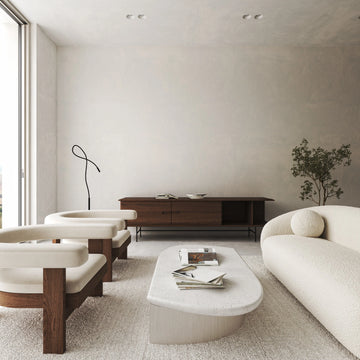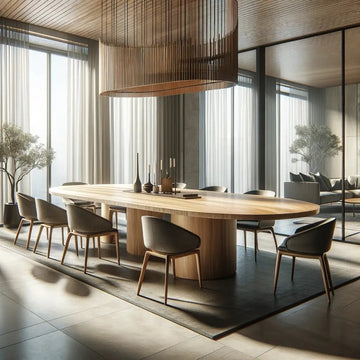Discover the Minimalist Elegance: 90 Unique Features of Japandi Style You Never Knew
by Robert William on Jun 09, 2023

What is Japandi Style?
Japandi style is a design trend that combines the best of Japanese minimalism and Scandinavian simplicity. It's all about the subtle balance of natural elements, clean lines, and calming colors. With Japandi style, less is definitely more. You won't find any clutter or excess in these spaces. Instead, Japandi style is all about creating a serene environment that promotes relaxation and tranquility.
This design style has become increasingly popular in recent years as people look for ways to simplify their lives and create a calming oasis in their homes. By blending the clean, functional aesthetic of Scandinavian design with the traditional, nature-inspired elements of Japanese design, Japandi style offers a unique and minimalist approach to interior design.
In this article, we'll explore 90 unique features of Japandi style that you may not have known about. From furniture to decor to color schemes, there are many ways to incorporate Japandi style into your home and create a space that feels peaceful and serene.
1. Japandi is a fusion of Japanese and Scandinavian design philosophies: This hybrid style embraces the minimalist and functional aspects of both cultures.
2. Furniture tends to be low to the ground: In keeping with traditional Japanese style, Japandi furniture is typically closer to the floor.
3. Japandi encourages living with less: A principle of this style is reducing clutter and focusing on what is essential, fostering a peaceful environment.
4. The concept of Wabi-sabi: This Japanese philosophy of embracing imperfection and transience is a core aspect of Japandi style.
5. Natural materials are key: Like the Scandinavian design, Japandi values the use of raw, organic materials like wood, stone, and plants.
6. Japandi is an eco-friendly style: Given its focus on sustainability and natural materials, this style is considered environmentally friendly.
7. Light plays a significant role: Natural lighting is prioritized, and when artificial lighting is used, it's kept soft and subtle.
8. Color scheme is mostly neutral: The Japandi style uses a lot of whites, blacks, and grays, punctuated with occasional earth tones.
9. Warm wood tones are prevalent: Unlike Scandinavian style which prefers lighter woods, Japandi includes darker, warm-toned woods.
10. Japandi borrows the Scandinavian concept of "Hygge": A Danish term referring to a sense of coziness and comfort, encouraging relaxation and well-being.
11. Outdoor elements are brought indoors: This style encourages an indoor-outdoor connection, with the use of plants, stones, and natural light.
12. It's a style suitable for small spaces: Given its minimalist approach, Japandi style can help make smaller spaces appear larger and more functional.
13. Japandi prefers quality over quantity: Choosing a few high-quality pieces is favored over filling the room with many items.
14. Japandi emphasizes functional aesthetics: Every item in the room should be useful, not just decorative.
15. Handmade elements are appreciated: Japandi style appreciates the artistry and uniqueness of handmade items.
16. Open spaces are a signature of Japandi: The style encourages free-flowing spaces to promote a sense of tranquility.
17. Japandi values symmetry and balance: Following the principles of Zen, Japandi spaces aim to maintain balance and harmony.
18. Rugs are often used for texture: While the flooring in Japandi design is typically wood, rugs can add warmth and texture.
19. Japandi style avoids heavy patterns: In keeping with the minimalist aesthetic, heavy patterns are generally avoided.
20. The style is rooted in respect for craftsmanship: Each item's design and construction are deeply appreciated.
21. Indoor plants play a crucial role: They connect us to nature and contribute to the overall tranquility of the space.
22. Contrast is important: Japandi uses contrast, such as pairing a sleek modern item with an older, handcrafted piece, to create visual interest.
23. Screen dividers are popular: Following Japanese tradition, screens can divide spaces while maintaining an open feel.
24. Aesthetics are minimalist, but not cold: Despite its minimalist approach, Japandi style aims to create a warm and inviting atmosphere.
25. Ceramic pieces are common: Handcrafted ceramic dishes or decorative pieces contribute to the style's authenticity.
26. Japandi style avoids plastic: In keeping with its respect for natural materials, plastic is rarely used.
27. Japandi incorporates multi-purpose furniture: In keeping with its functional ethos, Japandi encourages the use of adaptable, versatile furniture pieces.
28. Technology is hidden: Whenever possible, technology should be concealed to maintain the peaceful ambiance.
29. It celebrates the beauty of simplicity
30. Japandi can include pops of color: Although the palette is typically neutral, the addition of small bursts of muted, earthy colors is not uncommon.
31. Artwork in Japandi style is simplistic: This style prefers minimalist art, often inspired by nature.
32. Room layouts aim to promote serenity: Furniture placement encourages calmness and tranquility.
33. Use of geometric shapes: Square and rectangular forms are frequently seen in Japandi, in both architecture and furniture.
34. The use of bamboo: Bamboo, a traditional Japanese material, is often incorporated into Japandi design.
35. Japandi supports local craftspeople: Handmade items from local artisans are cherished.
36. Tactility is important: Textures are considered essential in Japandi, whether in textiles, ceramics, or wooden surfaces.
37. Japandi style is timeless: Its focus on functionality and simplicity ensures it never goes out of style.
38. Japandi spaces often feature "empty" areas: These spaces are not truly empty but rather, they provide a pause for the eye and contribute to the sense of tranquility.
39. "Ma" principle is observed: This Japanese concept refers to the appreciation of space and intervals, creating balance between occupied and unoccupied spaces.
40. Earthy tones are often used: These colors, inspired by nature, create a calming environment.
41. Linen is a preferred textile: It provides a light, natural texture in keeping with the overall aesthetic.
42. Japandi style isn't overly polished: The beauty in this style lies in the "lived-in" feel, rather than being too sleek or shiny.
43. Use of stone: Another natural material, stone is often used in Japandi design in the form of decorative pieces, tabletops, or even wall surfaces.
44. Subtle elegance is key: Japandi style aims for a look that's understated yet sophisticated.
45. Japandi is not about perfection: Wabi-sabi philosophy allows for imperfections, and they're seen as contributing to the uniqueness and beauty of the item or space.
46. No to excessive decoration: Over-decoration is avoided, as each piece must serve a purpose beyond just being ornamental.
47. Japandi focuses on creating a peaceful ambiance: The combination of minimalist design, natural elements, and a neutral palette contributes to an atmosphere of tranquility.
48. Natural fibers are favored: Cotton, linen, and wool are often used in Japandi design.
49. Soft furnishings are often neutral-toned: Cushions, throws, and other soft furnishings usually stick to the neutral color palette but can add warmth and texture.
50. Sleek lines are a characteristic: Clean, sleek lines in architecture, furniture, and decor are a staple of the Japandi style.
51. Shoji screens may be incorporated: These traditional Japanese screens, made of paper and wood, can be used as a window or room divider.
52. Japandi style can make use of muted greens and blues: Though the color palette is mostly neutral, these shades can sometimes be used to add a touch of calmness and serenity.
53. Japandi design values sustainability: Choosing sustainable materials and local crafts aligns with the environmental consciousness of this style.
54. Use of rattan: This flexible and strong material adds a natural, rustic touch to Japandi interiors.
55. Sliding doors and windows: Drawing from Japanese architecture, sliding doors and windows can be incorporated into Japandi design for practicality and aesthetics.
56. Connection with the garden: If a garden or outdoor space is available, a visual and physical connection with it is often established in Japandi design.
58. Japandi style can suit a variety of budgets: From high-end artisan pieces to more affordable, minimalist furniture, this style can cater to different spending capacities.
59. The use of 'Tatami' mats: These traditional Japanese straw mats can be used in a modern Japandi space for authentic touch and comfort.
60. Minimal hardware: Japandi design prefers the 'less is more' approach, even when it comes to hardware like knobs and handles on furniture.
61. The use of traditional Japanese 'Noren' curtains: These split curtains can be used for transitions between rooms, while maintaining an open and airy feel.
62. Importance of acoustics: Soft textiles and natural materials can help to create a peaceful, quiet environment which is a crucial aspect of Japandi style.
63. Use of Zen gardens: For those with outdoor spaces, the addition of a Zen rock garden can perfectly complement the indoor Japandi aesthetics.
64. Blend of old and new: While Japandi style is undeniably modern, it's not uncommon to see traditional elements blended in for a unique, timeless look.
65. The concept of 'Ikigai': This Japanese concept, meaning 'reason for being', is often represented in Japandi style by creating spaces that bring joy and purpose.
66. The use of 'Kintsugi': This traditional Japanese technique of repairing broken ceramics with gold lacquer can be seen in Japandi interiors, reflecting the Wabi-sabi philosophy of seeing beauty in imperfection.
67. Black is used as an accent color: In contrast to the predominantly neutral color palette, black is often used sparingly to define and highlight.
68. Use of 'Bonsai' trees: These miniaturized trees can be an ideal way to introduce greenery and a sense of peace to a Japandi space.
69. Application of Japandi in architecture: Japandi is not just for interiors. Its principles of minimalism, functionality, and harmony with nature can be applied to architecture as well.
70. Round shapes are embraced too: Although sleek lines and geometric shapes are common, softer, round forms also find their place in Japandi style.
71. Comfort is as important as aesthetics: Japandi design believes in creating spaces that are not just visually appealing, but also cozy and comfortable.
72. Use of 'Shibori' textiles: This traditional Japanese dyeing technique can be applied to cushions or throws for a unique touch.
73. Use of platform beds: Low, platform beds are a common feature of Japandi bedrooms, adhering to the preference for low furniture.
74. Combination of different wood tones: While warm wood tones are dominant, a mix of light and dark woods can be used for visual interest.
75. Japandi is not trend-driven: Its core principles make it a style that transcends trends and remains relevant regardless of what's currently popular in interior design.
76. Use of 'Sumi-e' (ink wash painting): Artworks employing this traditional Japanese technique can be incorporated into a Japandi space.
77. Absence of wall-to-wall carpets: Japandi prefers natural wooden floors, often with the addition of area rugs for warmth and texture.
78. Use of 'Ikebana' (Japanese flower arrangement): This traditional art can add a touch of nature and elegance to a Japandi interior.
79. Minimal window treatments: The aim is to let in as much natural light as possible, so heavy drapes are typically avoided.
80. Respect for the lifecycle of objects: Japandi design values items that age gracefully and prefers not to replace items until it's absolutely necessary.




